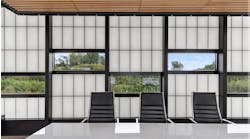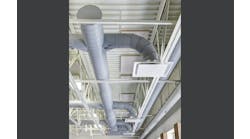Evidence continues to emerge about the effect indoor air quality has on a student's ability to learn. One study cited by the U.S. Environmental Protection Agency shows moderate changes in room temperature affect children's abilities to perform mental tasks requiring concentration, such as addition, multiplication and sentence comprehension.
As a result, the EPA suggests, "… [S]chools should be designed, built and maintained in ways to minimize and control sources of pollution, provide adequate exhaust and outdoor air ventilation by natural and mechanical means, (and) maintain proper temperature and humidity conditions. Failure to deal adequately with any of these issues … can and often does take its toll on health, comfort, and performance of teachers and students in school."
Yet, school administrators are under financial pressure to defer or eliminate capital expenses not directly related to education. Substantial investments such as central plant upgrades or expansions often are put on hold. Many institutions are forced to continue operating equipment for as long as possible in what's commonly referred to as "run-to-fail" mode.
The uncertainty of today's economy is forcing many educators to tempt fate. The strategy may be understandable, but it is not without risk. If equipment fails, contingency plans for temporary cooling must be in place if schools are to recover without significantly affecting operations or student performance.
Passing the Test
A contingency plan must include both the specification of temporary cooling equipment and a strategy for putting it into place. What good is backup equipment if it cannot be installed seamlessly and maintained reliably?
A comprehensive contingency plan should begin with site preparation. Site preparation is vital to the seamless installation of temporary cooling equipment. Long before the need arises, schools should identify a location for the rental equipment that will not only accommodate the chiller(s), but also provide access to required electrical and mechanical connections. By mapping the details of the installation in advance, schools can avoid the panic and overtime costs often associated with the use of temporary cooling — especially in an emergency.
A comprehensive contingency plan also should include provisions for the commissioning, maintenance and decommissioning of temporary cooling equipment. Education institutions should look for a plan for service and support within a contingency strategy; factory-trained service technicians should be available 24/7 to respond to school needs. A plan that can be carried out immediately keeps service disruptions to a minimum.
To develop and carry out the plan, schools should consider a supplier that can demonstrate expertise, availability and flexibility. The supplier should have in-depth knowledge of temporary equipment and installations, and experience in application engineering, project management and service. Selecting a partner with a range of capabilities can ensure that a contingency plan will be comprehensive. It should include a needs assessment, site preparation, installation, setup, commissioning, controls integration and ongoing maintenance of rented HVAC equipment.
When there's a need for temporary cooling, schools can't afford to be delayed by long delivery times, so it's important to work with a supplier that has a large inventory and quick delivery options.
Institutions also should select a rental partner that is flexible enough to consider various financial arrangements. Even if cash flow is limited or there is not budget for a major capital expenditure, customized rental agreements, including rent-to-own programs, can be drafted to meet specific needs.
Beyond the Crisis
Although a well-planned temporary cooling strategy enables schools and universities to prevent a worst-case scenario, it also may uncover additional opportunities for institutions to take advantage of benefits from temporary cooling:
-
Increased efficiency
Temporary cooling units often are the most reliable and most energy-efficient HVAC models on the market. By installing a temporary unit, schools and universities can validate energy savings and system requirements before purchasing new chiller equipment. In this "try before you buy" scenario, institutions may be able to rent the exact equipment slated for purchase. In addition, once a permanent replacement is specified, having a rental chiller in place enables operations to continue undisturbed while new equipment is ordered and installed.
-
Conserve the bottom line
When capital budgets are threatened, renting cooling equipment provides access to the newest technologies without making a long-term financial commitment to purchase. As an operational expense, temporary cooling can:
-
Bridge the gap until the economic climate stabilizes and budgeting issues can be resolved.
-
Provide additional cooling capacity during seasonal heat waves or natural disasters.
-
Offer universities the flexibility to accommodate peaks in enrollment as more adults head back to school.
-
Provide K-12 schools the capacity to provide comfortable environments during what is often the warmest time of the year.
-
-
Minimize downtime and risk
In the event of a cooling crisis, time is critical. Institutions must be prepared with backup — even backup to the backup — if they are to minimize downtime. In the wake of such an emergency, rental systems provide both redundancy cooling and peace of mind. They also can help to minimize risk during more routine circumstances.
When taking a chiller offline for scheduled maintenance, for example, temporary equipment enables operations to continue while those procedures are being performed. Because there is no need to rush to get the unit back online, planners can have peace of mind knowing maintenance is being done thoroughly and correctly — the first time.
- Read the "Planning Today for Tomorrow" sidebar to learn about contingency plans for temporary cooling.
McGraw is director, Johnson Controls Rental and Modular Solutions, Indianapolis. [email protected]
Related Stories
Planning Today for Tomorrow
Temporary cooling offers schools and universities the flexibility they need today, while providing a consistently comfortable, productive learning environment for students.
Whether planned or unplanned, short or long term, contingency plans for temporary cooling can be developed to cover:
-
Lack of available capital to purchase new chillers.
-
Emergency cooling in the wake of equipment breakdown.
-
Peaks in enrollment.
-
Changes in schedules, such as a move to accommodate year-round learning.
-
Seasonal heat waves or natural disasters.
-
Taking a chiller offline for routine maintenance but need operations to continue.
-
Stand-by cooling when a primary or backup system fails.
-
Delays while waiting for new chiller equipment to be installed.
Although temporary cooling most frequently is associated with emergencies, it provides benefits under a number of circumstances and offers peace of mind when cooling is critical to maintaining operations and providing a comfortable, productive learning environment.



